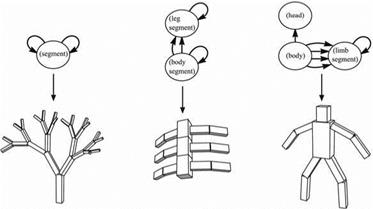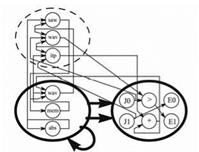In 1994 Sims showed “Evolved Virtual Creatures” a video animation in which simple block structures in a virtual environment move around in a partially bizarre way. The movements were not programmed or produced using techniques such as key framing, but originated from a virtual motoric of the block structures coupled with a sensor system, which had developed over hundreds of steps – the objects had learned to move themselves. Here, visible in the sophisticated dynamics, a strong interest in the computer-aided simulation of movement can be recognized. While in Panspermia evolutionary techniques were applied only to the morphology of the plants, Sims now turned to the evolution of movement.
|
“Evolved Virtual Creatures” shows examples of simple block structures, which swim, walk, jump or can follow a goal. Sims does not only simply try to move
well-known functioning constructions such as snakes, bipedal figures etc., but Section 12.2 also applies the evolutionary principle to both the motoric of skeleton-like Karl Sims
 |
 |
structures and the development of their topology. In this way he avoids letting our preconception of the morphology of a functioning organism determine the possible results. Part of the fascination when regarding his video is the fact that the creatures in no way correspond to our conceptions of a functioning mechanical system, but nevertheless develop strategies in order to reach their given goals.
A quotation from Karl Sims: “Sometimes the evolving creatures would think of solutions completely different than what I expected. In this one example, the creatures got taller and taller and taller and would simply fall over. Instead of figuring out some clever way of walking, they would fall to generate horizontal velocity. What I was telling them to do was just to move, and falling was a perfectly reasonable solution as far as they were concerned. So this creature specialized in falling for as long as it possibly could, including doing a complete somersault” [90]. All developed structures appear “authentic”, since they apparently move in conformity with the laws of physics.
The only aesthetic basic assumption in this connection is that we accept a movement as natural if it originates from a comprehensible motivation, and is limited through the physical characteristics of the moving body as well as the medium in which it moves.
Sims examines the abilities of the evolved structures using simulations in well – known media. For example, the structures should be able to move on a surface or swim through water. In the implemented simulation collision recognition and reaction with, for example, the soil and with other creatures, and selfpenetration, friction, and viscose liquid simulation are incorporated. The physical simulation needs here approximately 95% of the computing time. In [200] the scientific and technical background of this work is described.
The generated structures consist of a skeleton, whose parts are connected by joints. The genetic representation of the object consisting of coupled partial objects is an aligned graph of nodes and edges. This graph contains “the con-
struction rules” of the creature. It can also contain recursions, and two nodes may be connected with several edges, in order to link, for example, the same substructure several times to the same father.
 Figure 12.6 Example of evolved nested graph genotype. The outer graph in bold describes a creature’s morphology. The inner graph describes its neural circuitry. J0 and J1 are joint angle sensors, and E0 and E1 are effector outputs. The dashed node contains centralized neurons that are not associated with any part
Figure 12.6 Example of evolved nested graph genotype. The outer graph in bold describes a creature’s morphology. The inner graph describes its neural circuitry. J0 and J1 are joint angle sensors, and E0 and E1 are effector outputs. The dashed node contains centralized neurons that are not associated with any part
The nodes are connected by joints; different types of joints permit different degrees of freedom of the movement, such as, for instance, firmly connected, rotatory, twisted, flexible or ball joints. The rotation is restricted using given maximum angles and simulated springs. The phenotype in the form of a threedimensional structure is generated by traversion of these graphs, starting at a root node, and reading out of the node information, such as the physical dimension and joint information. Figure 12.5 shows three examples of graphs and the resulting three-dimensional hierarchy; Figure 12.6 shows a detailed graph with neurons.
![]() Similarly to this concept, in Chap. 6 the structure of a plant was modeled: the morphology is generated also by the interaction of different nodes that in each case describe parts of the plant. Also the graph is traversed for the production of the form, however without movement information.
Similarly to this concept, in Chap. 6 the structure of a plant was modeled: the morphology is generated also by the interaction of different nodes that in each case describe parts of the plant. Also the graph is traversed for the production of the form, however without movement information.
Sims controls the movement of a creature using its so-called brain. The brain consists of three functional groups:
■ Sensors measure aspects of the body, such as degrees of freedom of a joint, or aspects of the environment, such as the direction of the incident light.
■ Neurons process detailed information about a set of mathematical functions and return the result. Neurons can store information, such as the phase of an oscillation, and thereby make the behavior dependent on the condition of the creature.
■ Effectors are connected with sensors or neurons; they are the digital equivalent to muscles, and affect joint angles by application of force.
In each simulation step, the movement of the creature is computed by its brain, based on the incoming data and how it is processed. The resulting forces on the joints are then introduced into the physical simulation of the movement.
While in Panspermia the individuals were selected mostly aesthetically by human intuition, in this work fixed fitness functions are given: when swimming,
the distance that a creature can swim was measured within one time unit in an arbitrary direction in a water-similar medium; continuous movements were preferred. For the running on the ground, the horizontal speed was determined; when jumping it was the vertical one. When pursuing a goal, the speed at which creatures in different media followed a (partly moving) source of light that could be recognized by photosensors was measured. Thus, not only the efficiency of the motoric, but also the capability of the sensory organs were measured. in a further test two creatures entered a race after a given block. That creature that was able to catch the block was preferred. Here the fitness function is not purely external, but is computed from the comparison of different individuals.



